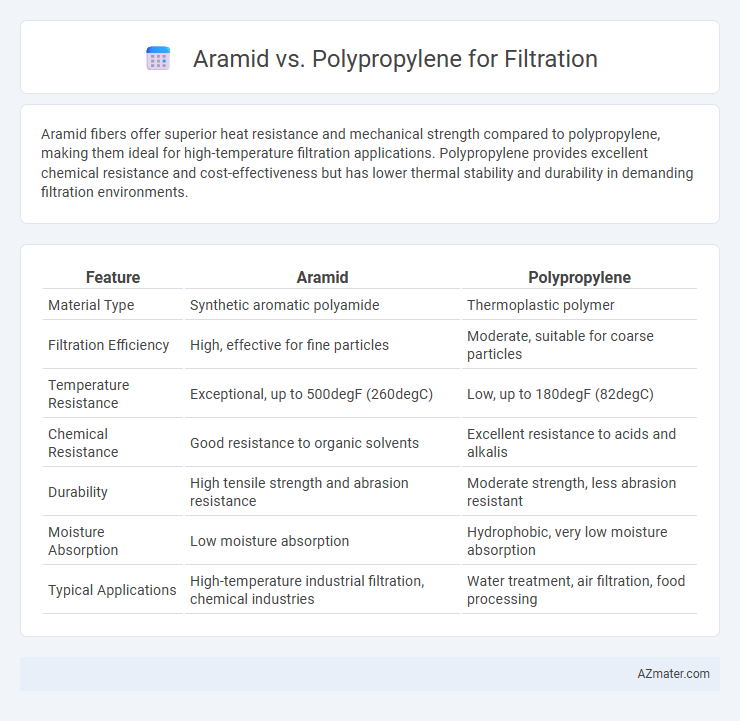Aramid fibers offer superior heat resistance and mechanical strength compared to polypropylene, making them ideal for high-temperature filtration applications. Polypropylene provides excellent chemical resistance and cost-effectiveness but has lower thermal stability and durability in demanding filtration environments.
Table of Comparison
| Feature | Aramid | Polypropylene |
|---|---|---|
| Material Type | Synthetic aromatic polyamide | Thermoplastic polymer |
| Filtration Efficiency | High, effective for fine particles | Moderate, suitable for coarse particles |
| Temperature Resistance | Exceptional, up to 500degF (260degC) | Low, up to 180degF (82degC) |
| Chemical Resistance | Good resistance to organic solvents | Excellent resistance to acids and alkalis |
| Durability | High tensile strength and abrasion resistance | Moderate strength, less abrasion resistant |
| Moisture Absorption | Low moisture absorption | Hydrophobic, very low moisture absorption |
| Typical Applications | High-temperature industrial filtration, chemical industries | Water treatment, air filtration, food processing |
Introduction to Filtration Materials
Aramid fibers exhibit exceptional thermal stability and chemical resistance, making them ideal for high-performance filtration applications requiring durability and strength. Polypropylene is favored for its low cost, chemical inertness, and hydrophobic properties, providing effective filtration in environments where moisture resistance and affordability are critical. Selecting the appropriate material depends on specific filtration needs such as temperature tolerance, chemical exposure, and filter lifespan.
Overview of Aramid Fibers
Aramid fibers, known for their exceptional strength, thermal stability, and chemical resistance, excel in filtration applications requiring durability under harsh conditions. These synthetic fibers offer superior resistance to abrasion, high temperatures up to 400degC, and a low weight-to-strength ratio, making them ideal for industrial filters in automotive, aerospace, and chemical processing. Compared to polypropylene, aramid provides enhanced mechanical performance and longevity in demanding filtration environments.
Overview of Polypropylene Fibers
Polypropylene fibers are widely favored in filtration applications due to their exceptional chemical resistance, low density, and hydrophobic properties, which enhance durability and flow efficiency. These fibers exhibit strong resistance to acids, alkalis, and organic solvents, making them suitable for a broad range of industrial filtration processes, including liquid and air filtration. Their cost-effectiveness, combined with thermal stability up to approximately 130degC, positions polypropylene as a versatile alternative to aramid fibers, particularly in environments less demanding of high-temperature resistance.
Physical and Chemical Properties Comparison
Aramid fibers exhibit superior tensile strength, thermal stability up to 500degF (260degC), and excellent chemical resistance to solvents and acids, making them ideal for high-performance filtration in harsh environments. Polypropylene offers good chemical resistance and low density but has lower melting points around 320degF (160degC) and reduced mechanical strength compared to aramid. The choice between aramid and polypropylene depends on filtration conditions such as temperature tolerance, chemical exposure, and required durability.
Filtration Efficiency and Performance
Aramid fibers exhibit superior filtration efficiency due to their high thermal stability, chemical resistance, and fine fiber diameter, enabling effective capture of submicron particles in hazardous environments. Polypropylene offers cost-effective filtration with hydrophobic properties and good mechanical strength but generally falls short in capturing ultra-fine particulate matter compared to aramid. Performance-wise, aramid maintains structural integrity under high temperatures and aggressive chemical exposure, making it ideal for industrial filtration applications requiring durability and high efficiency.
Thermal and Chemical Resistance
Aramid fibers exhibit superior thermal resistance withstanding temperatures up to 500degF (260degC), making them ideal for high-temperature filtration applications, while polypropylene melts at around 320degF (160degC), limiting its use in heat-intensive environments. Chemically, aramid offers excellent resistance to acids and organic solvents but degrades when exposed to strong alkalis, whereas polypropylene demonstrates broad chemical resistance, including to acids, alkalis, and solvents, ensuring versatile filtration performance in various harsh chemical environments. The choice between aramid and polypropylene depends on the specific thermal and chemical demands of the filtration process.
Durability and Lifespan in Filtration Applications
Aramid fibers exhibit superior durability and lifespan in filtration applications due to their high tensile strength, heat resistance up to 500degF, and chemical stability, making them ideal for harsh environments and long-term use. Polypropylene, while cost-effective and resistant to many chemicals, has lower thermal resistance and mechanical strength, leading to faster degradation under high-temperature or heavy-duty filtration conditions. Choosing aramid results in longer filter service life and reduced maintenance, especially in demanding industrial filtration systems.
Environmental Impact and Sustainability
Aramid fibers exhibit superior chemical resistance and durability in filtration applications, leading to longer service life and reduced waste compared to polypropylene, which is less resistant to UV degradation and oxidation. Polypropylene is recyclable and derived from lower-cost petrochemical processes, but its shorter lifespan increases environmental burden through more frequent replacements. Choosing aramid for filtration can enhance sustainability by minimizing landfill contributions and lowering energy consumption associated with repeated manufacturing cycles.
Cost and Economic Considerations
Aramid fibers typically have a higher initial cost compared to polypropylene due to their advanced heat resistance and durability, making them suitable for high-performance filtration applications. Polypropylene offers a lower-cost alternative with reasonable chemical resistance and acceptable filtration efficiency for less demanding environments. Evaluating long-term economic benefits involves considering the lifespan and maintenance frequency, where aramid may reduce replacement and operational costs despite its higher upfront investment.
Choosing the Right Material for Your Filtration Needs
Aramid fibers offer exceptional heat resistance and high tensile strength, making them ideal for filtration applications involving high temperatures or abrasive particles. Polypropylene provides excellent chemical resistance and cost-efficiency, suitable for filtering acidic or alkaline fluids where lower temperature tolerance is acceptable. Selecting the right material depends on specific filtration requirements such as temperature range, chemical exposure, and mechanical durability.

Infographic: Aramid vs Polypropylene for Filtration
 azmater.com
azmater.com